Report on Advanced Financial Accounting: Impairment and Leases
VerifiedAdded on 2020/05/28
|13
|2574
|85
Report
AI Summary
This report provides an in-depth analysis of advanced financial accounting, focusing on impairment testing and lease accounting, particularly in the context of Virgin Australia. The report examines the company's approach to impairment testing, including the assessment of financial assets, the determination of cash-generating units, and the recognition of impairment losses. It also delves into the impact of the new lease accounting standard, discussing the shortcomings of the previous standard, the benefits of the new standard in terms of transparency and comparability, and the perspectives of stakeholders such as the IASB chairman. The report highlights the significance of the new rules in reflecting the correct financial state of lessees and enabling better decision-making among investors. Furthermore, it analyzes the potential impact of the new lease accounting standard on financial metrics and reporting, emphasizing the need for organizations to conduct preliminary assessments and establish robust internal control systems for its effective implementation. Overall, the report offers a comprehensive overview of these critical accounting topics, providing valuable insights into financial reporting practices and the implications of accounting standards.
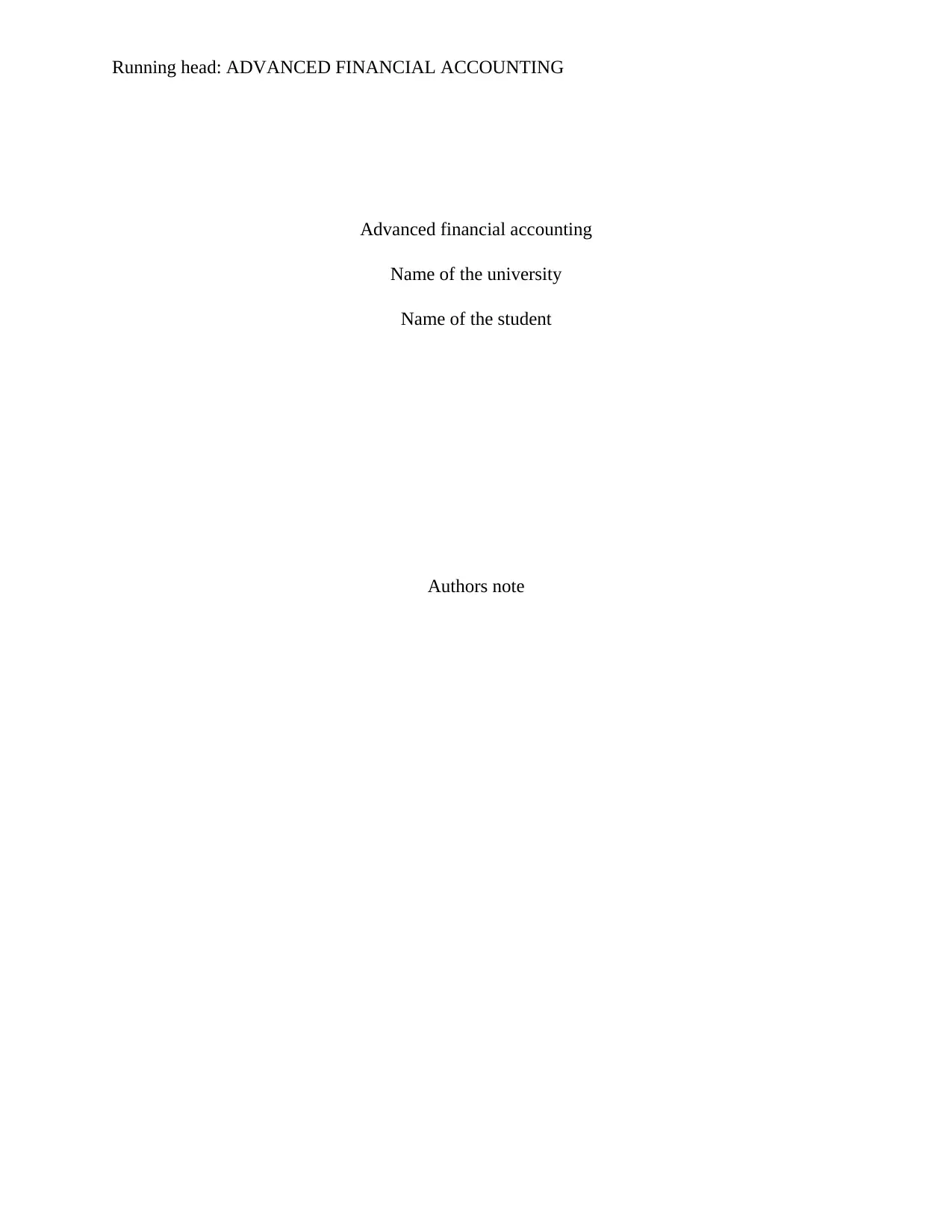
Running head: ADVANCED FINANCIAL ACCOUNTING
Advanced financial accounting
Name of the university
Name of the student
Authors note
Advanced financial accounting
Name of the university
Name of the student
Authors note
Paraphrase This Document
Need a fresh take? Get an instant paraphrase of this document with our AI Paraphraser
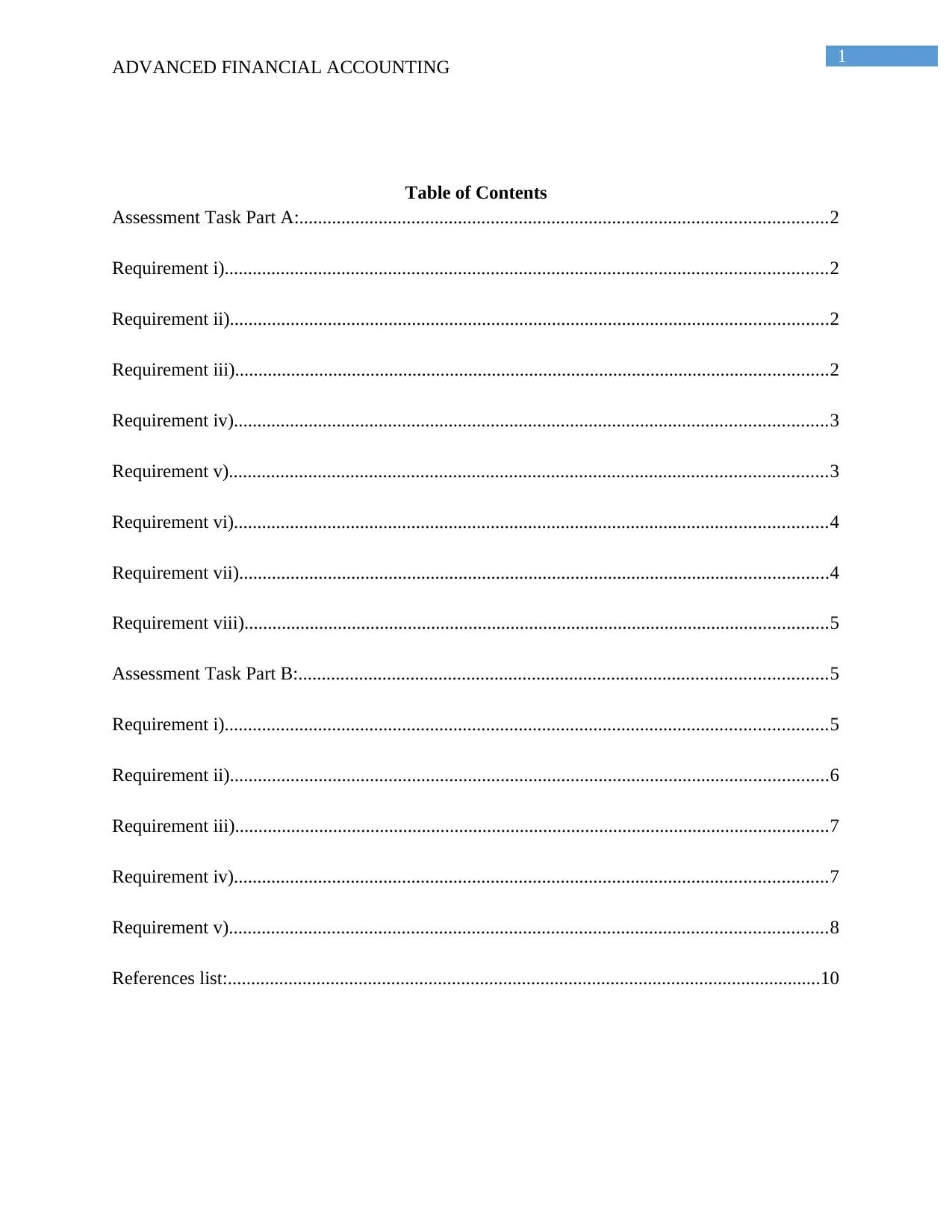
1
ADVANCED FINANCIAL ACCOUNTING
Table of Contents
Assessment Task Part A:.................................................................................................................2
Requirement i).................................................................................................................................2
Requirement ii)................................................................................................................................2
Requirement iii)...............................................................................................................................2
Requirement iv)...............................................................................................................................3
Requirement v)................................................................................................................................3
Requirement vi)...............................................................................................................................4
Requirement vii)..............................................................................................................................4
Requirement viii).............................................................................................................................5
Assessment Task Part B:.................................................................................................................5
Requirement i).................................................................................................................................5
Requirement ii)................................................................................................................................6
Requirement iii)...............................................................................................................................7
Requirement iv)...............................................................................................................................7
Requirement v)................................................................................................................................8
References list:...............................................................................................................................10
ADVANCED FINANCIAL ACCOUNTING
Table of Contents
Assessment Task Part A:.................................................................................................................2
Requirement i).................................................................................................................................2
Requirement ii)................................................................................................................................2
Requirement iii)...............................................................................................................................2
Requirement iv)...............................................................................................................................3
Requirement v)................................................................................................................................3
Requirement vi)...............................................................................................................................4
Requirement vii)..............................................................................................................................4
Requirement viii).............................................................................................................................5
Assessment Task Part B:.................................................................................................................5
Requirement i).................................................................................................................................5
Requirement ii)................................................................................................................................6
Requirement iii)...............................................................................................................................7
Requirement iv)...............................................................................................................................7
Requirement v)................................................................................................................................8
References list:...............................................................................................................................10
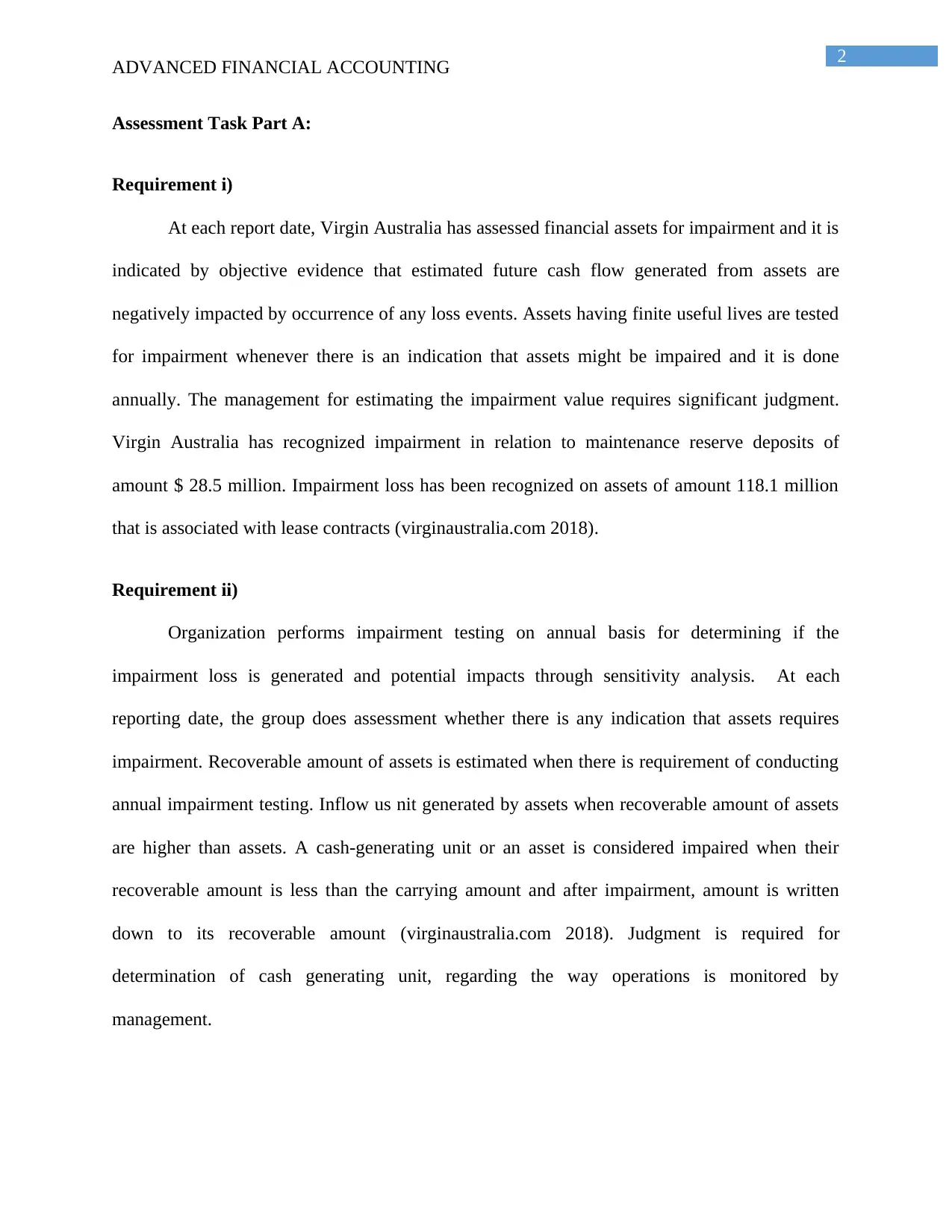
2
ADVANCED FINANCIAL ACCOUNTING
Assessment Task Part A:
Requirement i)
At each report date, Virgin Australia has assessed financial assets for impairment and it is
indicated by objective evidence that estimated future cash flow generated from assets are
negatively impacted by occurrence of any loss events. Assets having finite useful lives are tested
for impairment whenever there is an indication that assets might be impaired and it is done
annually. The management for estimating the impairment value requires significant judgment.
Virgin Australia has recognized impairment in relation to maintenance reserve deposits of
amount $ 28.5 million. Impairment loss has been recognized on assets of amount 118.1 million
that is associated with lease contracts (virginaustralia.com 2018).
Requirement ii)
Organization performs impairment testing on annual basis for determining if the
impairment loss is generated and potential impacts through sensitivity analysis. At each
reporting date, the group does assessment whether there is any indication that assets requires
impairment. Recoverable amount of assets is estimated when there is requirement of conducting
annual impairment testing. Inflow us nit generated by assets when recoverable amount of assets
are higher than assets. A cash-generating unit or an asset is considered impaired when their
recoverable amount is less than the carrying amount and after impairment, amount is written
down to its recoverable amount (virginaustralia.com 2018). Judgment is required for
determination of cash generating unit, regarding the way operations is monitored by
management.
ADVANCED FINANCIAL ACCOUNTING
Assessment Task Part A:
Requirement i)
At each report date, Virgin Australia has assessed financial assets for impairment and it is
indicated by objective evidence that estimated future cash flow generated from assets are
negatively impacted by occurrence of any loss events. Assets having finite useful lives are tested
for impairment whenever there is an indication that assets might be impaired and it is done
annually. The management for estimating the impairment value requires significant judgment.
Virgin Australia has recognized impairment in relation to maintenance reserve deposits of
amount $ 28.5 million. Impairment loss has been recognized on assets of amount 118.1 million
that is associated with lease contracts (virginaustralia.com 2018).
Requirement ii)
Organization performs impairment testing on annual basis for determining if the
impairment loss is generated and potential impacts through sensitivity analysis. At each
reporting date, the group does assessment whether there is any indication that assets requires
impairment. Recoverable amount of assets is estimated when there is requirement of conducting
annual impairment testing. Inflow us nit generated by assets when recoverable amount of assets
are higher than assets. A cash-generating unit or an asset is considered impaired when their
recoverable amount is less than the carrying amount and after impairment, amount is written
down to its recoverable amount (virginaustralia.com 2018). Judgment is required for
determination of cash generating unit, regarding the way operations is monitored by
management.
⊘ This is a preview!⊘
Do you want full access?
Subscribe today to unlock all pages.

Trusted by 1+ million students worldwide
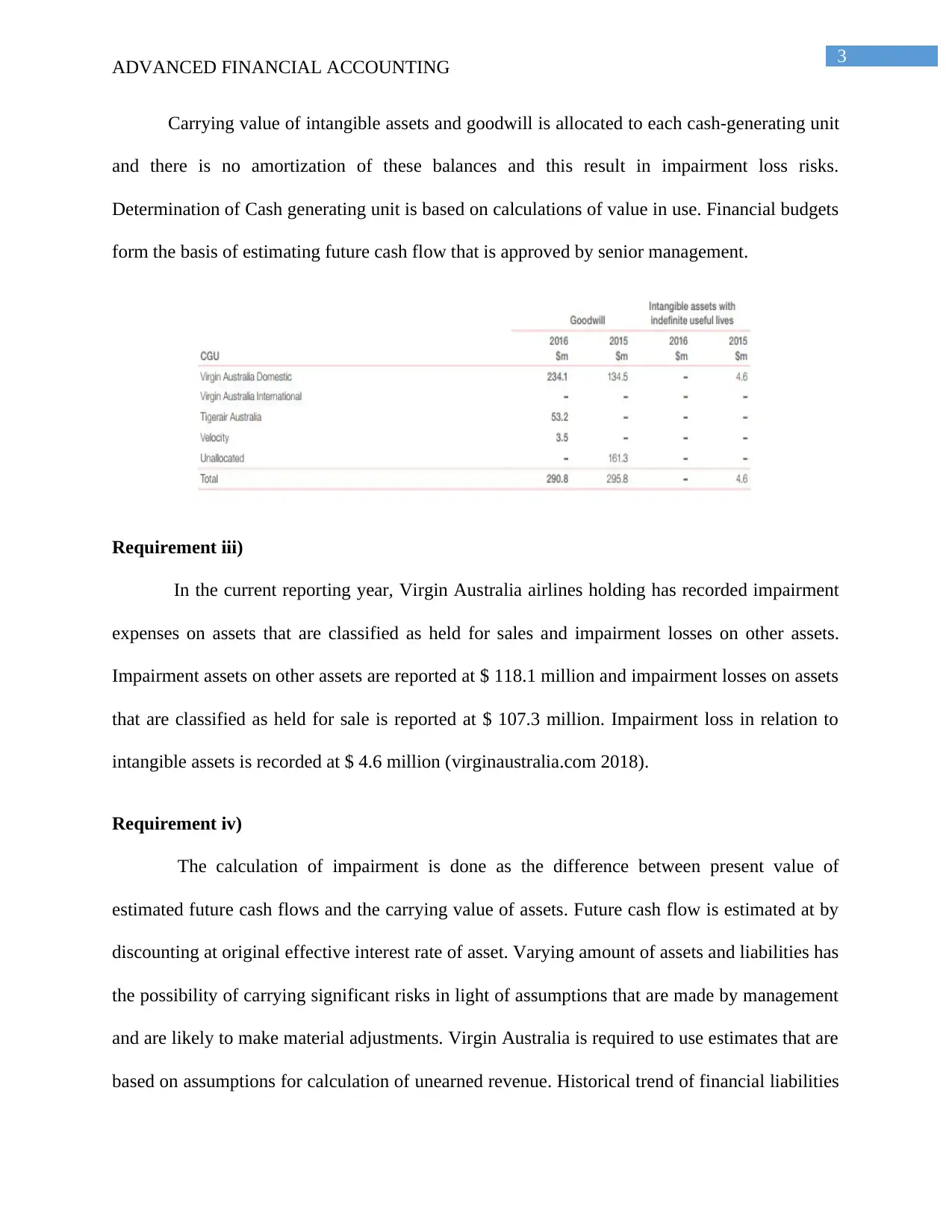
3
ADVANCED FINANCIAL ACCOUNTING
Carrying value of intangible assets and goodwill is allocated to each cash-generating unit
and there is no amortization of these balances and this result in impairment loss risks.
Determination of Cash generating unit is based on calculations of value in use. Financial budgets
form the basis of estimating future cash flow that is approved by senior management.
Requirement iii)
In the current reporting year, Virgin Australia airlines holding has recorded impairment
expenses on assets that are classified as held for sales and impairment losses on other assets.
Impairment assets on other assets are reported at $ 118.1 million and impairment losses on assets
that are classified as held for sale is reported at $ 107.3 million. Impairment loss in relation to
intangible assets is recorded at $ 4.6 million (virginaustralia.com 2018).
Requirement iv)
The calculation of impairment is done as the difference between present value of
estimated future cash flows and the carrying value of assets. Future cash flow is estimated at by
discounting at original effective interest rate of asset. Varying amount of assets and liabilities has
the possibility of carrying significant risks in light of assumptions that are made by management
and are likely to make material adjustments. Virgin Australia is required to use estimates that are
based on assumptions for calculation of unearned revenue. Historical trend of financial liabilities
ADVANCED FINANCIAL ACCOUNTING
Carrying value of intangible assets and goodwill is allocated to each cash-generating unit
and there is no amortization of these balances and this result in impairment loss risks.
Determination of Cash generating unit is based on calculations of value in use. Financial budgets
form the basis of estimating future cash flow that is approved by senior management.
Requirement iii)
In the current reporting year, Virgin Australia airlines holding has recorded impairment
expenses on assets that are classified as held for sales and impairment losses on other assets.
Impairment assets on other assets are reported at $ 118.1 million and impairment losses on assets
that are classified as held for sale is reported at $ 107.3 million. Impairment loss in relation to
intangible assets is recorded at $ 4.6 million (virginaustralia.com 2018).
Requirement iv)
The calculation of impairment is done as the difference between present value of
estimated future cash flows and the carrying value of assets. Future cash flow is estimated at by
discounting at original effective interest rate of asset. Varying amount of assets and liabilities has
the possibility of carrying significant risks in light of assumptions that are made by management
and are likely to make material adjustments. Virgin Australia is required to use estimates that are
based on assumptions for calculation of unearned revenue. Historical trend of financial liabilities
Paraphrase This Document
Need a fresh take? Get an instant paraphrase of this document with our AI Paraphraser
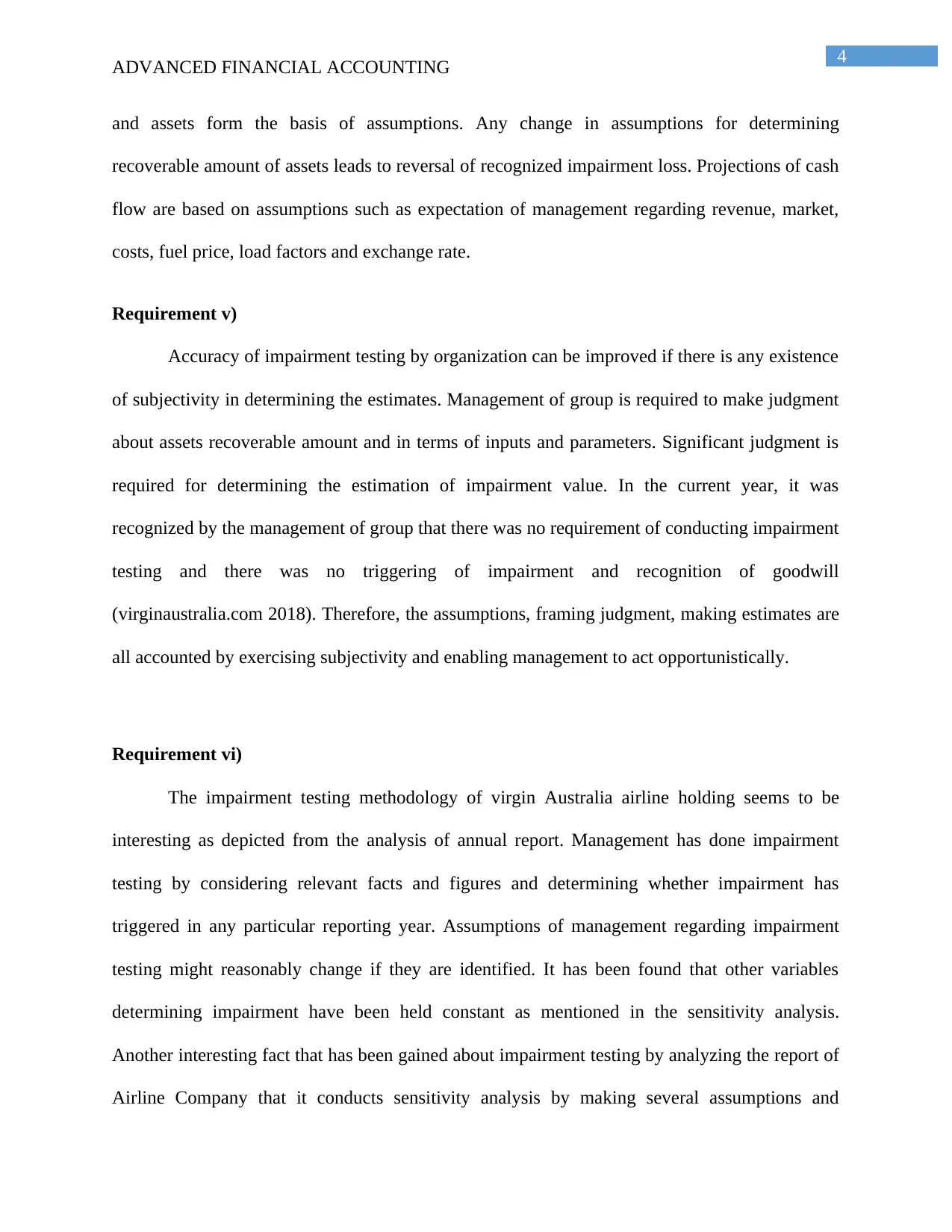
4
ADVANCED FINANCIAL ACCOUNTING
and assets form the basis of assumptions. Any change in assumptions for determining
recoverable amount of assets leads to reversal of recognized impairment loss. Projections of cash
flow are based on assumptions such as expectation of management regarding revenue, market,
costs, fuel price, load factors and exchange rate.
Requirement v)
Accuracy of impairment testing by organization can be improved if there is any existence
of subjectivity in determining the estimates. Management of group is required to make judgment
about assets recoverable amount and in terms of inputs and parameters. Significant judgment is
required for determining the estimation of impairment value. In the current year, it was
recognized by the management of group that there was no requirement of conducting impairment
testing and there was no triggering of impairment and recognition of goodwill
(virginaustralia.com 2018). Therefore, the assumptions, framing judgment, making estimates are
all accounted by exercising subjectivity and enabling management to act opportunistically.
Requirement vi)
The impairment testing methodology of virgin Australia airline holding seems to be
interesting as depicted from the analysis of annual report. Management has done impairment
testing by considering relevant facts and figures and determining whether impairment has
triggered in any particular reporting year. Assumptions of management regarding impairment
testing might reasonably change if they are identified. It has been found that other variables
determining impairment have been held constant as mentioned in the sensitivity analysis.
Another interesting fact that has been gained about impairment testing by analyzing the report of
Airline Company that it conducts sensitivity analysis by making several assumptions and
ADVANCED FINANCIAL ACCOUNTING
and assets form the basis of assumptions. Any change in assumptions for determining
recoverable amount of assets leads to reversal of recognized impairment loss. Projections of cash
flow are based on assumptions such as expectation of management regarding revenue, market,
costs, fuel price, load factors and exchange rate.
Requirement v)
Accuracy of impairment testing by organization can be improved if there is any existence
of subjectivity in determining the estimates. Management of group is required to make judgment
about assets recoverable amount and in terms of inputs and parameters. Significant judgment is
required for determining the estimation of impairment value. In the current year, it was
recognized by the management of group that there was no requirement of conducting impairment
testing and there was no triggering of impairment and recognition of goodwill
(virginaustralia.com 2018). Therefore, the assumptions, framing judgment, making estimates are
all accounted by exercising subjectivity and enabling management to act opportunistically.
Requirement vi)
The impairment testing methodology of virgin Australia airline holding seems to be
interesting as depicted from the analysis of annual report. Management has done impairment
testing by considering relevant facts and figures and determining whether impairment has
triggered in any particular reporting year. Assumptions of management regarding impairment
testing might reasonably change if they are identified. It has been found that other variables
determining impairment have been held constant as mentioned in the sensitivity analysis.
Another interesting fact that has been gained about impairment testing by analyzing the report of
Airline Company that it conducts sensitivity analysis by making several assumptions and
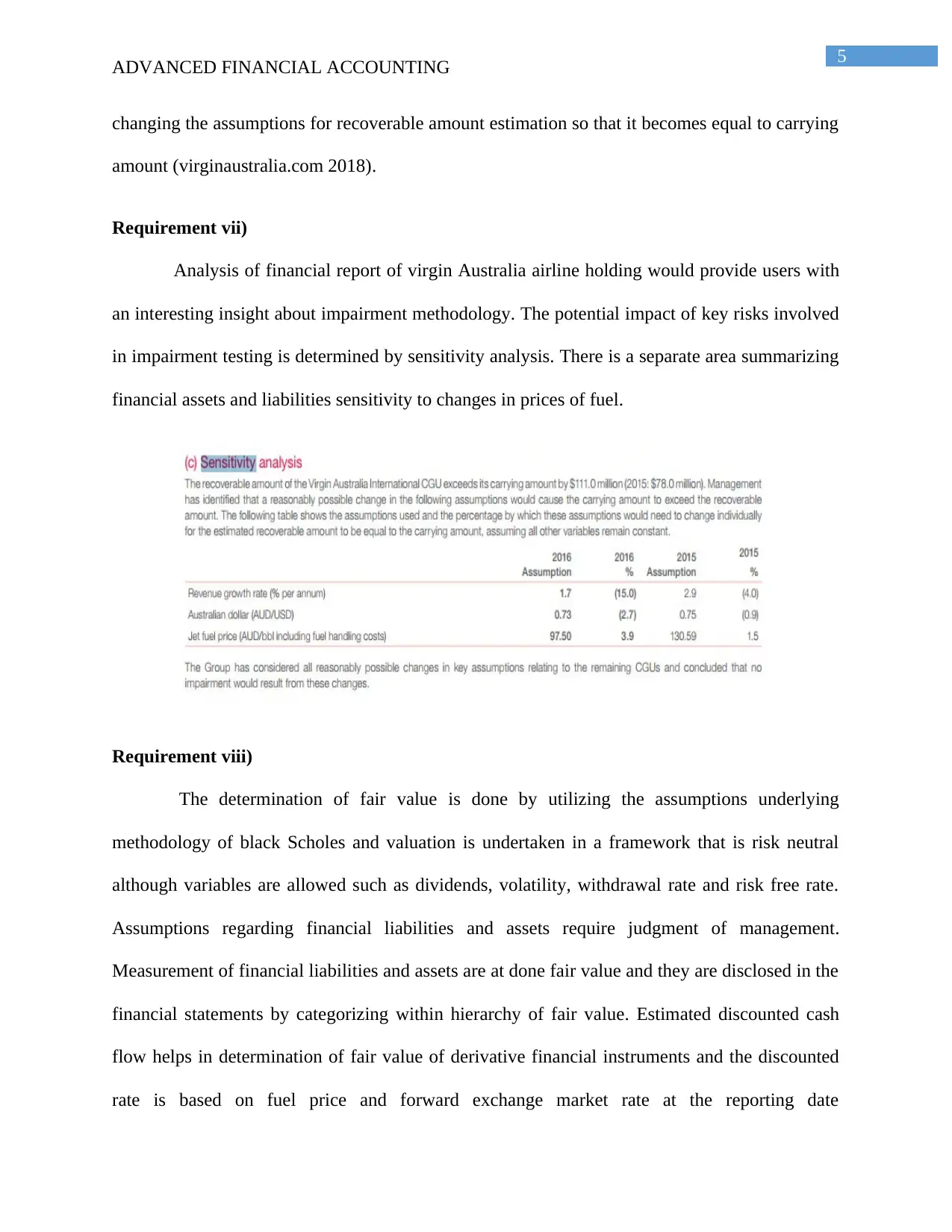
5
ADVANCED FINANCIAL ACCOUNTING
changing the assumptions for recoverable amount estimation so that it becomes equal to carrying
amount (virginaustralia.com 2018).
Requirement vii)
Analysis of financial report of virgin Australia airline holding would provide users with
an interesting insight about impairment methodology. The potential impact of key risks involved
in impairment testing is determined by sensitivity analysis. There is a separate area summarizing
financial assets and liabilities sensitivity to changes in prices of fuel.
Requirement viii)
The determination of fair value is done by utilizing the assumptions underlying
methodology of black Scholes and valuation is undertaken in a framework that is risk neutral
although variables are allowed such as dividends, volatility, withdrawal rate and risk free rate.
Assumptions regarding financial liabilities and assets require judgment of management.
Measurement of financial liabilities and assets are at done fair value and they are disclosed in the
financial statements by categorizing within hierarchy of fair value. Estimated discounted cash
flow helps in determination of fair value of derivative financial instruments and the discounted
rate is based on fuel price and forward exchange market rate at the reporting date
ADVANCED FINANCIAL ACCOUNTING
changing the assumptions for recoverable amount estimation so that it becomes equal to carrying
amount (virginaustralia.com 2018).
Requirement vii)
Analysis of financial report of virgin Australia airline holding would provide users with
an interesting insight about impairment methodology. The potential impact of key risks involved
in impairment testing is determined by sensitivity analysis. There is a separate area summarizing
financial assets and liabilities sensitivity to changes in prices of fuel.
Requirement viii)
The determination of fair value is done by utilizing the assumptions underlying
methodology of black Scholes and valuation is undertaken in a framework that is risk neutral
although variables are allowed such as dividends, volatility, withdrawal rate and risk free rate.
Assumptions regarding financial liabilities and assets require judgment of management.
Measurement of financial liabilities and assets are at done fair value and they are disclosed in the
financial statements by categorizing within hierarchy of fair value. Estimated discounted cash
flow helps in determination of fair value of derivative financial instruments and the discounted
rate is based on fuel price and forward exchange market rate at the reporting date
⊘ This is a preview!⊘
Do you want full access?
Subscribe today to unlock all pages.

Trusted by 1+ million students worldwide
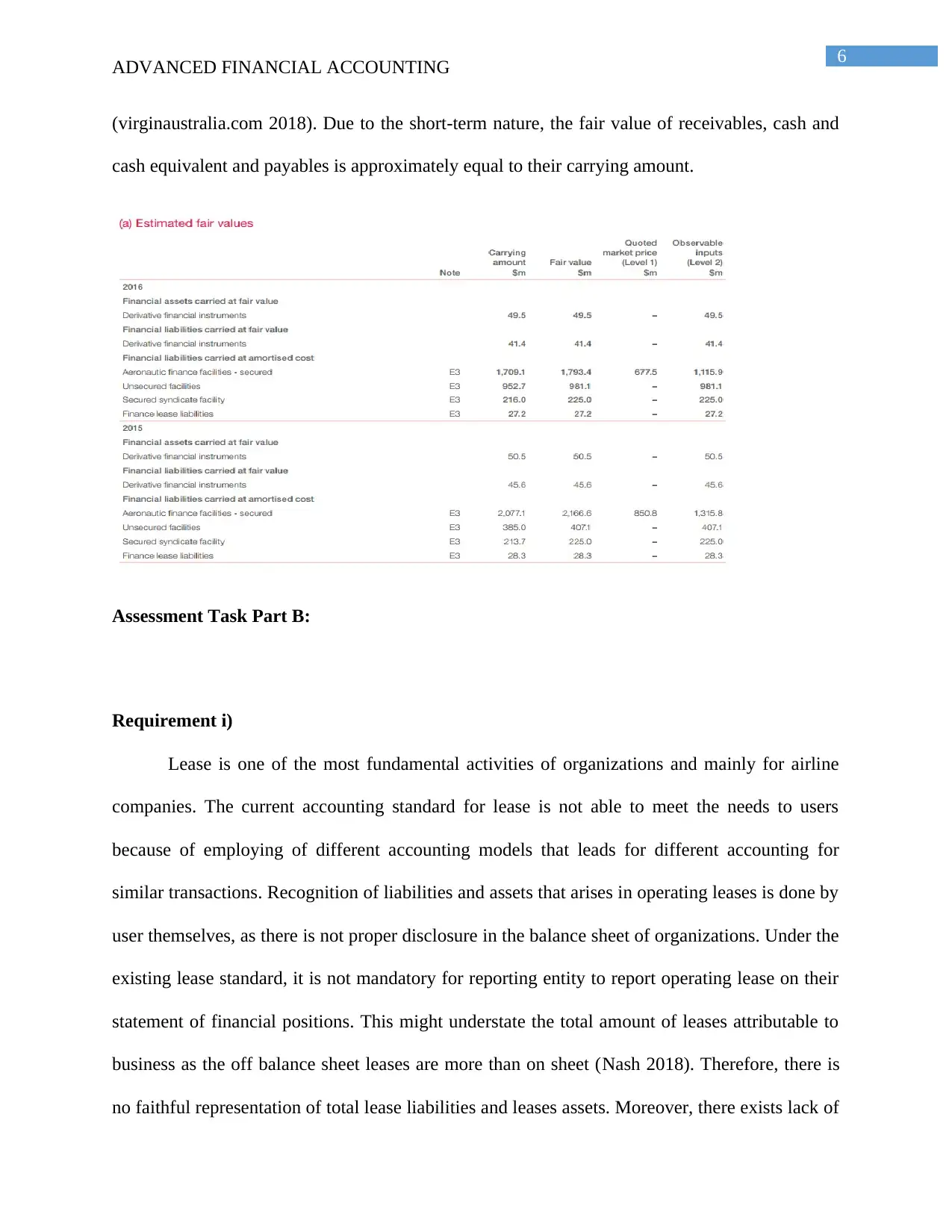
6
ADVANCED FINANCIAL ACCOUNTING
(virginaustralia.com 2018). Due to the short-term nature, the fair value of receivables, cash and
cash equivalent and payables is approximately equal to their carrying amount.
Assessment Task Part B:
Requirement i)
Lease is one of the most fundamental activities of organizations and mainly for airline
companies. The current accounting standard for lease is not able to meet the needs to users
because of employing of different accounting models that leads for different accounting for
similar transactions. Recognition of liabilities and assets that arises in operating leases is done by
user themselves, as there is not proper disclosure in the balance sheet of organizations. Under the
existing lease standard, it is not mandatory for reporting entity to report operating lease on their
statement of financial positions. This might understate the total amount of leases attributable to
business as the off balance sheet leases are more than on sheet (Nash 2018). Therefore, there is
no faithful representation of total lease liabilities and leases assets. Moreover, there exists lack of
ADVANCED FINANCIAL ACCOUNTING
(virginaustralia.com 2018). Due to the short-term nature, the fair value of receivables, cash and
cash equivalent and payables is approximately equal to their carrying amount.
Assessment Task Part B:
Requirement i)
Lease is one of the most fundamental activities of organizations and mainly for airline
companies. The current accounting standard for lease is not able to meet the needs to users
because of employing of different accounting models that leads for different accounting for
similar transactions. Recognition of liabilities and assets that arises in operating leases is done by
user themselves, as there is not proper disclosure in the balance sheet of organizations. Under the
existing lease standard, it is not mandatory for reporting entity to report operating lease on their
statement of financial positions. This might understate the total amount of leases attributable to
business as the off balance sheet leases are more than on sheet (Nash 2018). Therefore, there is
no faithful representation of total lease liabilities and leases assets. Moreover, there exists lack of
Paraphrase This Document
Need a fresh take? Get an instant paraphrase of this document with our AI Paraphraser
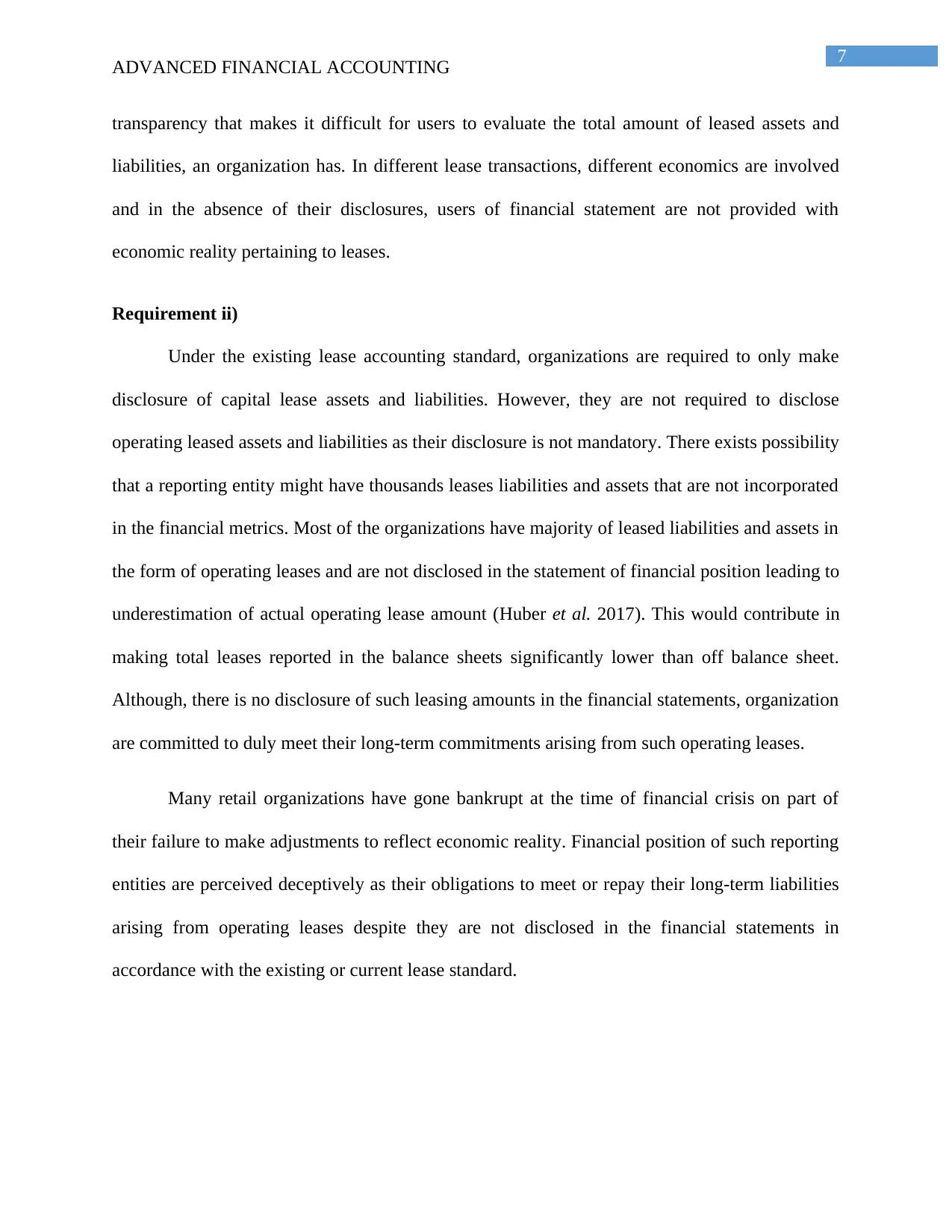
7
ADVANCED FINANCIAL ACCOUNTING
transparency that makes it difficult for users to evaluate the total amount of leased assets and
liabilities, an organization has. In different lease transactions, different economics are involved
and in the absence of their disclosures, users of financial statement are not provided with
economic reality pertaining to leases.
Requirement ii)
Under the existing lease accounting standard, organizations are required to only make
disclosure of capital lease assets and liabilities. However, they are not required to disclose
operating leased assets and liabilities as their disclosure is not mandatory. There exists possibility
that a reporting entity might have thousands leases liabilities and assets that are not incorporated
in the financial metrics. Most of the organizations have majority of leased liabilities and assets in
the form of operating leases and are not disclosed in the statement of financial position leading to
underestimation of actual operating lease amount (Huber et al. 2017). This would contribute in
making total leases reported in the balance sheets significantly lower than off balance sheet.
Although, there is no disclosure of such leasing amounts in the financial statements, organization
are committed to duly meet their long-term commitments arising from such operating leases.
Many retail organizations have gone bankrupt at the time of financial crisis on part of
their failure to make adjustments to reflect economic reality. Financial position of such reporting
entities are perceived deceptively as their obligations to meet or repay their long-term liabilities
arising from operating leases despite they are not disclosed in the financial statements in
accordance with the existing or current lease standard.
ADVANCED FINANCIAL ACCOUNTING
transparency that makes it difficult for users to evaluate the total amount of leased assets and
liabilities, an organization has. In different lease transactions, different economics are involved
and in the absence of their disclosures, users of financial statement are not provided with
economic reality pertaining to leases.
Requirement ii)
Under the existing lease accounting standard, organizations are required to only make
disclosure of capital lease assets and liabilities. However, they are not required to disclose
operating leased assets and liabilities as their disclosure is not mandatory. There exists possibility
that a reporting entity might have thousands leases liabilities and assets that are not incorporated
in the financial metrics. Most of the organizations have majority of leased liabilities and assets in
the form of operating leases and are not disclosed in the statement of financial position leading to
underestimation of actual operating lease amount (Huber et al. 2017). This would contribute in
making total leases reported in the balance sheets significantly lower than off balance sheet.
Although, there is no disclosure of such leasing amounts in the financial statements, organization
are committed to duly meet their long-term commitments arising from such operating leases.
Many retail organizations have gone bankrupt at the time of financial crisis on part of
their failure to make adjustments to reflect economic reality. Financial position of such reporting
entities are perceived deceptively as their obligations to meet or repay their long-term liabilities
arising from operating leases despite they are not disclosed in the financial statements in
accordance with the existing or current lease standard.
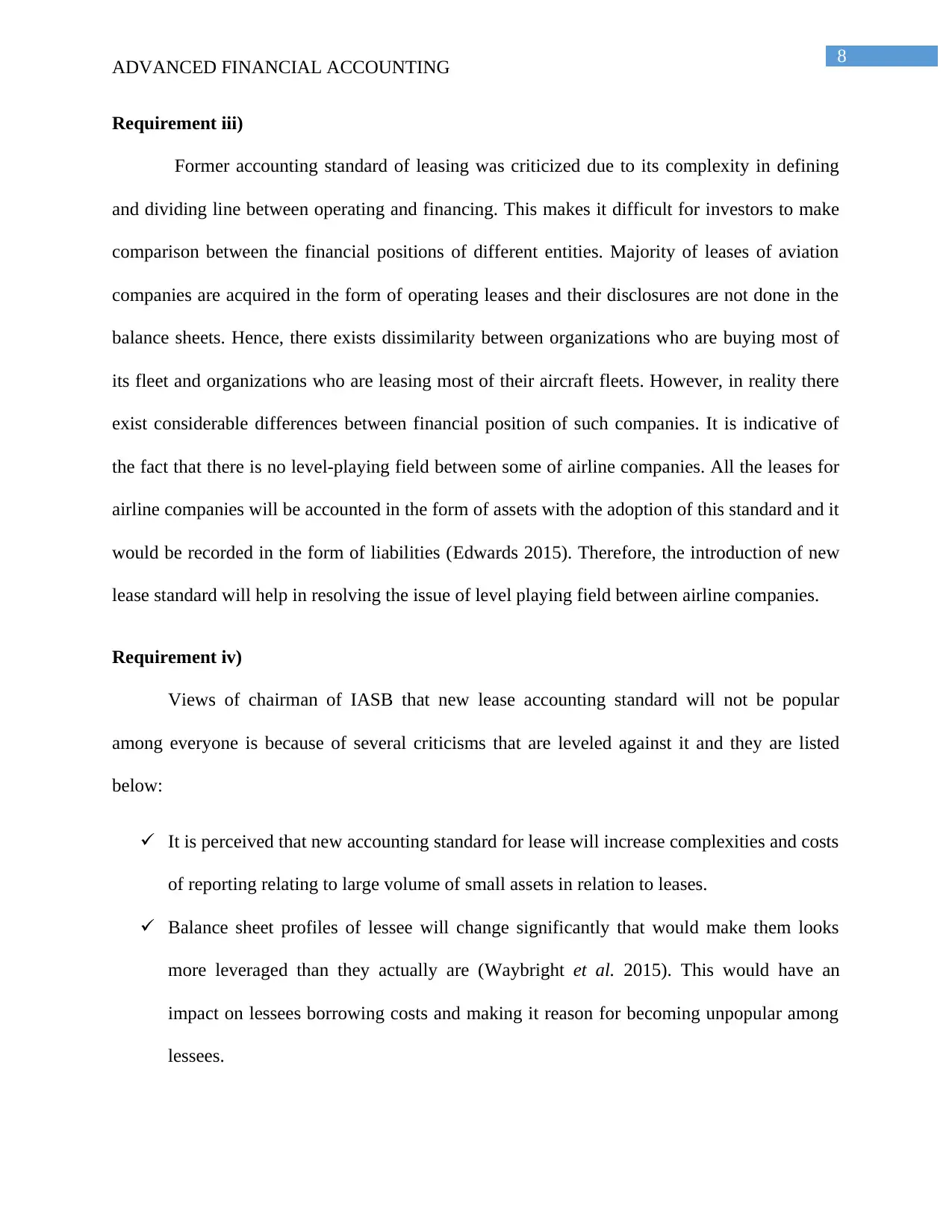
8
ADVANCED FINANCIAL ACCOUNTING
Requirement iii)
Former accounting standard of leasing was criticized due to its complexity in defining
and dividing line between operating and financing. This makes it difficult for investors to make
comparison between the financial positions of different entities. Majority of leases of aviation
companies are acquired in the form of operating leases and their disclosures are not done in the
balance sheets. Hence, there exists dissimilarity between organizations who are buying most of
its fleet and organizations who are leasing most of their aircraft fleets. However, in reality there
exist considerable differences between financial position of such companies. It is indicative of
the fact that there is no level-playing field between some of airline companies. All the leases for
airline companies will be accounted in the form of assets with the adoption of this standard and it
would be recorded in the form of liabilities (Edwards 2015). Therefore, the introduction of new
lease standard will help in resolving the issue of level playing field between airline companies.
Requirement iv)
Views of chairman of IASB that new lease accounting standard will not be popular
among everyone is because of several criticisms that are leveled against it and they are listed
below:
It is perceived that new accounting standard for lease will increase complexities and costs
of reporting relating to large volume of small assets in relation to leases.
Balance sheet profiles of lessee will change significantly that would make them looks
more leveraged than they actually are (Waybright et al. 2015). This would have an
impact on lessees borrowing costs and making it reason for becoming unpopular among
lessees.
ADVANCED FINANCIAL ACCOUNTING
Requirement iii)
Former accounting standard of leasing was criticized due to its complexity in defining
and dividing line between operating and financing. This makes it difficult for investors to make
comparison between the financial positions of different entities. Majority of leases of aviation
companies are acquired in the form of operating leases and their disclosures are not done in the
balance sheets. Hence, there exists dissimilarity between organizations who are buying most of
its fleet and organizations who are leasing most of their aircraft fleets. However, in reality there
exist considerable differences between financial position of such companies. It is indicative of
the fact that there is no level-playing field between some of airline companies. All the leases for
airline companies will be accounted in the form of assets with the adoption of this standard and it
would be recorded in the form of liabilities (Edwards 2015). Therefore, the introduction of new
lease standard will help in resolving the issue of level playing field between airline companies.
Requirement iv)
Views of chairman of IASB that new lease accounting standard will not be popular
among everyone is because of several criticisms that are leveled against it and they are listed
below:
It is perceived that new accounting standard for lease will increase complexities and costs
of reporting relating to large volume of small assets in relation to leases.
Balance sheet profiles of lessee will change significantly that would make them looks
more leveraged than they actually are (Waybright et al. 2015). This would have an
impact on lessees borrowing costs and making it reason for becoming unpopular among
lessees.
⊘ This is a preview!⊘
Do you want full access?
Subscribe today to unlock all pages.

Trusted by 1+ million students worldwide

9
ADVANCED FINANCIAL ACCOUNTING
Some sophisticated lenders when lending to lessee already estimate the effect of leases
that are off balance sheet on leverage. Hence, reporting entity is not required to bring
them on balance sheets.
One of the factors is adequacy of knowledge on part of management for implementing
new lease standard. An organization is required to gather relevant facts and information
and make changes accordingly so that they get adapted to new system (Mader et al.
2015). However, existing financial metrics of organization will also be altered by the
implementation of this new leasing standard.
Requirement v)
The new rules that are framed for leasing as per new accounting standard will ensure that
balance sheets reflect lessees correct financial state of affairs. Moreover, lenders will be able to
get detailed and true information on credit risks of lessee and therefore, they will be well
equipped with understanding about pricing the risk of lending. For determining how lease
accounting will be affected by this new standard, it is required by reporting entity to conduct
preliminary assessment. It is also required to be ensured by entities that they have adequate
internal control system in place so that they are able to collect necessary information for
implementation of new standard. A detailed guidance is provided to organizations for
determining whether contract is service contract or lease contract (Eng et al. 2014).
Organizations working heavily with operating leases will be considerably impacted by this new
lease standard. There will be reasonable uncertainty by exercising leasing options relating to
economic reality. Moreover, lease accounting will enable better and informed decision among
investors in terms of determining contract terms, calculations and leasing practice that leads to
identification of relevant leased assets relating to leasing operations. Investors under new
ADVANCED FINANCIAL ACCOUNTING
Some sophisticated lenders when lending to lessee already estimate the effect of leases
that are off balance sheet on leverage. Hence, reporting entity is not required to bring
them on balance sheets.
One of the factors is adequacy of knowledge on part of management for implementing
new lease standard. An organization is required to gather relevant facts and information
and make changes accordingly so that they get adapted to new system (Mader et al.
2015). However, existing financial metrics of organization will also be altered by the
implementation of this new leasing standard.
Requirement v)
The new rules that are framed for leasing as per new accounting standard will ensure that
balance sheets reflect lessees correct financial state of affairs. Moreover, lenders will be able to
get detailed and true information on credit risks of lessee and therefore, they will be well
equipped with understanding about pricing the risk of lending. For determining how lease
accounting will be affected by this new standard, it is required by reporting entity to conduct
preliminary assessment. It is also required to be ensured by entities that they have adequate
internal control system in place so that they are able to collect necessary information for
implementation of new standard. A detailed guidance is provided to organizations for
determining whether contract is service contract or lease contract (Eng et al. 2014).
Organizations working heavily with operating leases will be considerably impacted by this new
lease standard. There will be reasonable uncertainty by exercising leasing options relating to
economic reality. Moreover, lease accounting will enable better and informed decision among
investors in terms of determining contract terms, calculations and leasing practice that leads to
identification of relevant leased assets relating to leasing operations. Investors under new
Paraphrase This Document
Need a fresh take? Get an instant paraphrase of this document with our AI Paraphraser
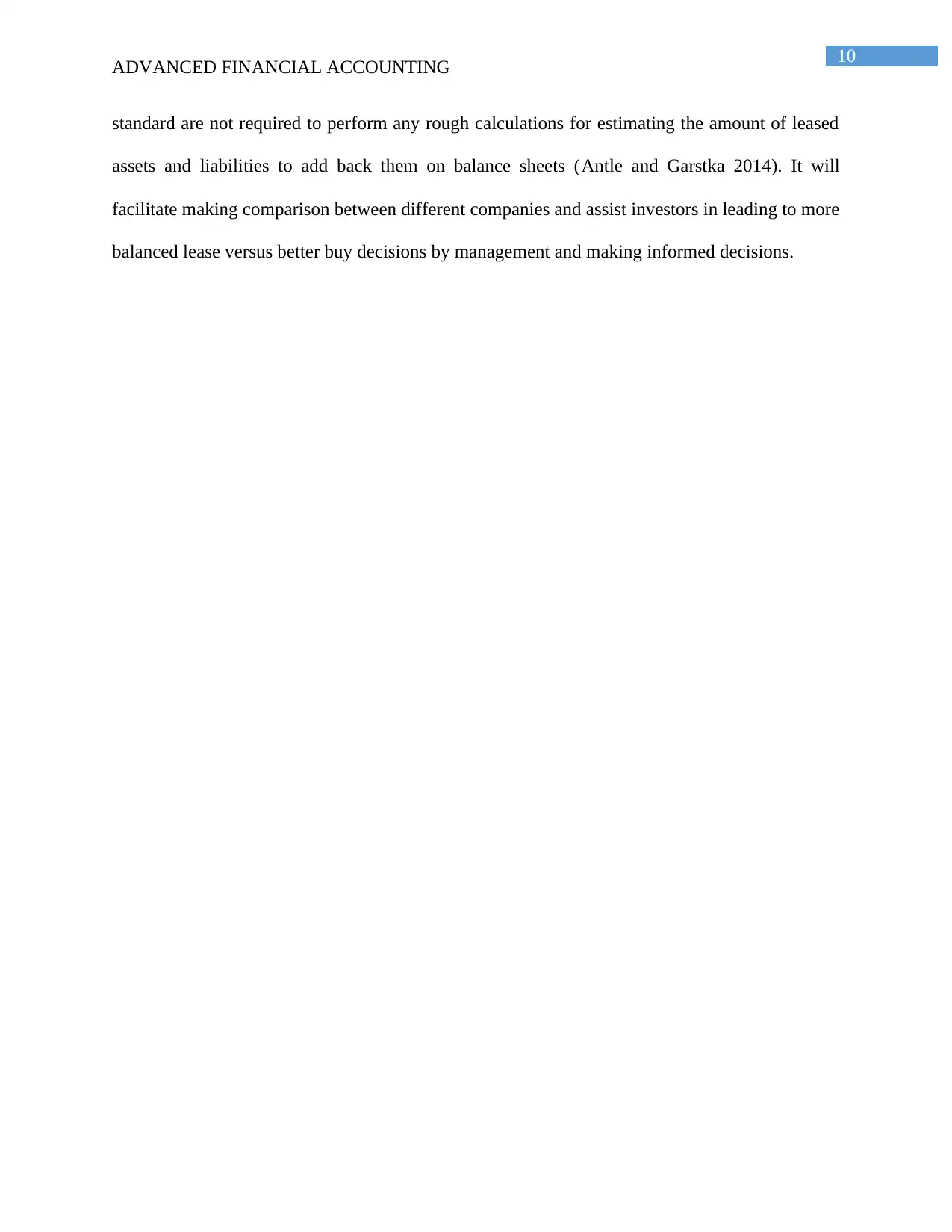
10
ADVANCED FINANCIAL ACCOUNTING
standard are not required to perform any rough calculations for estimating the amount of leased
assets and liabilities to add back them on balance sheets (Antle and Garstka 2014). It will
facilitate making comparison between different companies and assist investors in leading to more
balanced lease versus better buy decisions by management and making informed decisions.
ADVANCED FINANCIAL ACCOUNTING
standard are not required to perform any rough calculations for estimating the amount of leased
assets and liabilities to add back them on balance sheets (Antle and Garstka 2014). It will
facilitate making comparison between different companies and assist investors in leading to more
balanced lease versus better buy decisions by management and making informed decisions.
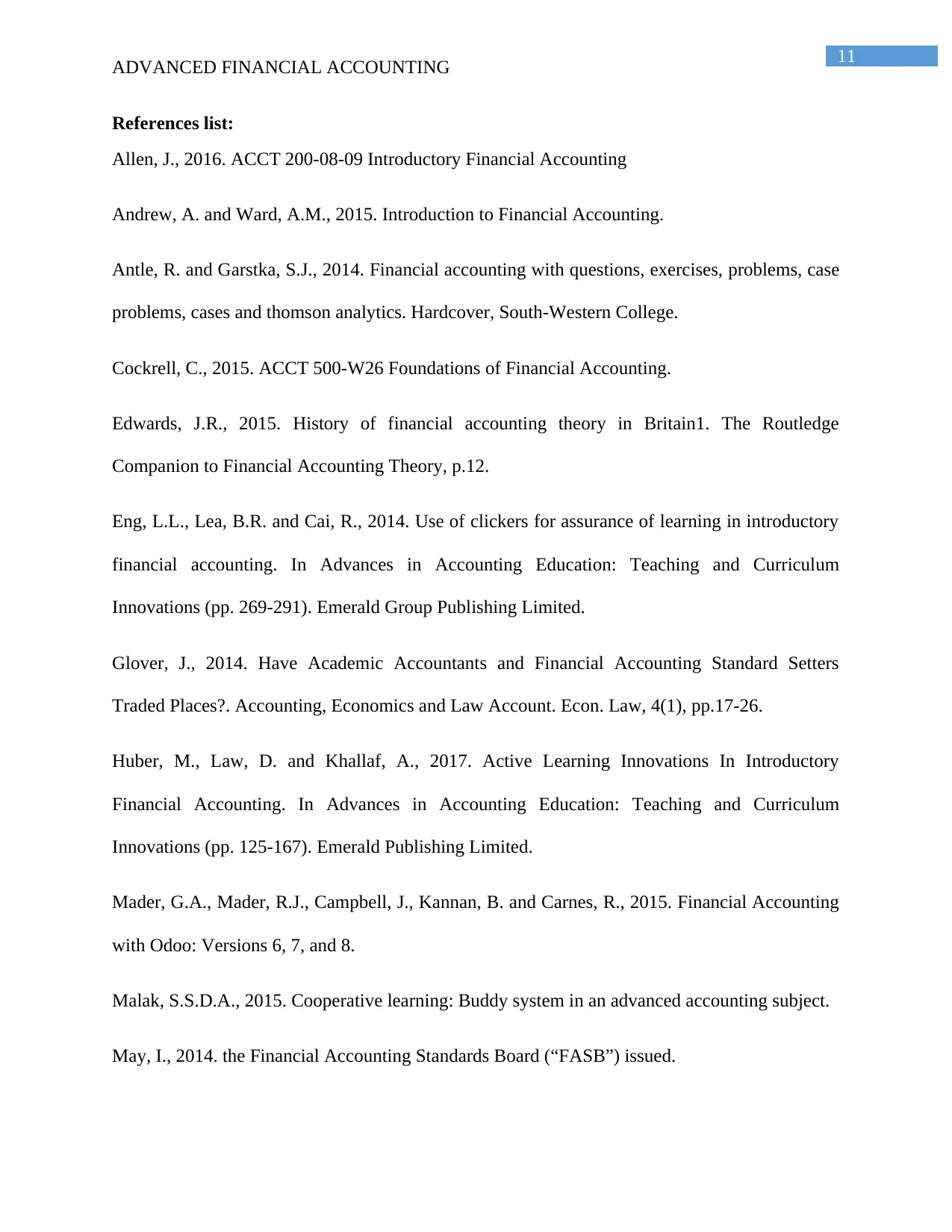
11
ADVANCED FINANCIAL ACCOUNTING
References list:
Allen, J., 2016. ACCT 200-08-09 Introductory Financial Accounting
Andrew, A. and Ward, A.M., 2015. Introduction to Financial Accounting.
Antle, R. and Garstka, S.J., 2014. Financial accounting with questions, exercises, problems, case
problems, cases and thomson analytics. Hardcover, South-Western College.
Cockrell, C., 2015. ACCT 500-W26 Foundations of Financial Accounting.
Edwards, J.R., 2015. History of financial accounting theory in Britain1. The Routledge
Companion to Financial Accounting Theory, p.12.
Eng, L.L., Lea, B.R. and Cai, R., 2014. Use of clickers for assurance of learning in introductory
financial accounting. In Advances in Accounting Education: Teaching and Curriculum
Innovations (pp. 269-291). Emerald Group Publishing Limited.
Glover, J., 2014. Have Academic Accountants and Financial Accounting Standard Setters
Traded Places?. Accounting, Economics and Law Account. Econ. Law, 4(1), pp.17-26.
Huber, M., Law, D. and Khallaf, A., 2017. Active Learning Innovations In Introductory
Financial Accounting. In Advances in Accounting Education: Teaching and Curriculum
Innovations (pp. 125-167). Emerald Publishing Limited.
Mader, G.A., Mader, R.J., Campbell, J., Kannan, B. and Carnes, R., 2015. Financial Accounting
with Odoo: Versions 6, 7, and 8.
Malak, S.S.D.A., 2015. Cooperative learning: Buddy system in an advanced accounting subject.
May, I., 2014. the Financial Accounting Standards Board (“FASB”) issued.
ADVANCED FINANCIAL ACCOUNTING
References list:
Allen, J., 2016. ACCT 200-08-09 Introductory Financial Accounting
Andrew, A. and Ward, A.M., 2015. Introduction to Financial Accounting.
Antle, R. and Garstka, S.J., 2014. Financial accounting with questions, exercises, problems, case
problems, cases and thomson analytics. Hardcover, South-Western College.
Cockrell, C., 2015. ACCT 500-W26 Foundations of Financial Accounting.
Edwards, J.R., 2015. History of financial accounting theory in Britain1. The Routledge
Companion to Financial Accounting Theory, p.12.
Eng, L.L., Lea, B.R. and Cai, R., 2014. Use of clickers for assurance of learning in introductory
financial accounting. In Advances in Accounting Education: Teaching and Curriculum
Innovations (pp. 269-291). Emerald Group Publishing Limited.
Glover, J., 2014. Have Academic Accountants and Financial Accounting Standard Setters
Traded Places?. Accounting, Economics and Law Account. Econ. Law, 4(1), pp.17-26.
Huber, M., Law, D. and Khallaf, A., 2017. Active Learning Innovations In Introductory
Financial Accounting. In Advances in Accounting Education: Teaching and Curriculum
Innovations (pp. 125-167). Emerald Publishing Limited.
Mader, G.A., Mader, R.J., Campbell, J., Kannan, B. and Carnes, R., 2015. Financial Accounting
with Odoo: Versions 6, 7, and 8.
Malak, S.S.D.A., 2015. Cooperative learning: Buddy system in an advanced accounting subject.
May, I., 2014. the Financial Accounting Standards Board (“FASB”) issued.
⊘ This is a preview!⊘
Do you want full access?
Subscribe today to unlock all pages.

Trusted by 1+ million students worldwide
1 out of 13
Related Documents
Your All-in-One AI-Powered Toolkit for Academic Success.
+13062052269
info@desklib.com
Available 24*7 on WhatsApp / Email
![[object Object]](/_next/static/media/star-bottom.7253800d.svg)
Unlock your academic potential
Copyright © 2020–2025 A2Z Services. All Rights Reserved. Developed and managed by ZUCOL.





